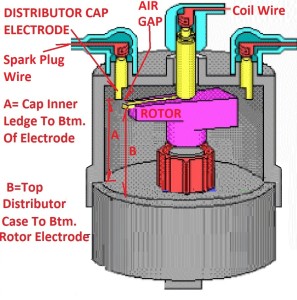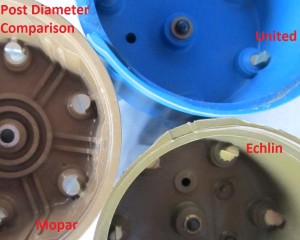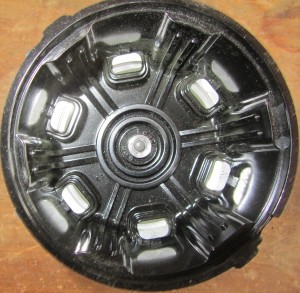Distributor Cap Quality Part 2 has the following vector files:
DistributorCapRotorGapMeasurementPart2 (.doc)
DistributorCapRotorGapMeasurementPart2 (.pdf)
Content of the files is as follows:
Distributor Cap Quality Part 2 covers another aspect on measuring the new cap that Part 1 did not cover……effecting the side to side gap between the rotor and distributor cap terminal. This is the easiest measurement yet to take standing in the store.
Part 1 covered the up/down distributor terminal/rotor gap. It also covered the importance of controlling the Total Physical Air Gap (TPAG) and the impact on coil wire voltage & ignition component life.
The picture looked like this:
Part 1 cap measurements focused on comparing the A and B dimension to determine the up/down gap that might be occurring because the cap was built with the distributor terminal too high up in the cap. Said another way the rotor wasn’t reaching up to the distributor terminal far enough. Part 2 concerns the diameter of the distributor terminal itself.
A picture showing several caps and their varying terminal diameters:
It’s obvious that if the terminal needs machining there is little material to machine on the United cap and more on the Mopar cap. But more importantly these diameters effect the side to side air gap between the rotor and distributor cap terminal.
Theory on the importance of the terminal diameter:
Grasp that the rotor is not always pointed directly at the distributor cap terminal when the spark occurs. Why? Since the vacuum and centrifugal advance alter the timing of the engine to adjust for engine load & rpm, the spark is occurring when the rotor position is variable relative to the distributor cap terminal(or angled away from it). How important is this? Take one look at the early 60’s style distributor cap terminals to see how strongly Detroit felt about it: note in the below picture the width of the terminals…..over .5”. Better yet get an early rotor that fits the cap such the TPAG is around .020” and the result is the coil has an easy job of pushing over the small gap. End result? Coil wire voltages drop below 2000 volts and the ignition components become more reliable and provide longer life than those dealing with large TPAG. Best of all the spark plug is operating at an optimum with great ignition secondary voltages at the plug. Find an old cap looking like this and know it’s purpose……. reducing side to side rotor to terminal air gaps:
Bottom Line: Measure the diameter of the distributor cap terminals while standing in the store. Expect numbers to range from 3/8 down to an itty bitty 5/32. Grab the cap with the biggest terminal diameter you can get (& meets the up/down measurement criteria).
Next up is the last gap measurement (in/out). Although this is the last contributor to the TPAG it’s normally the biggest & ugliest one.



